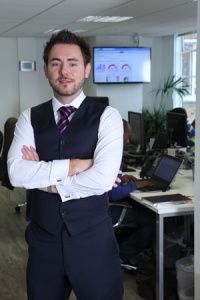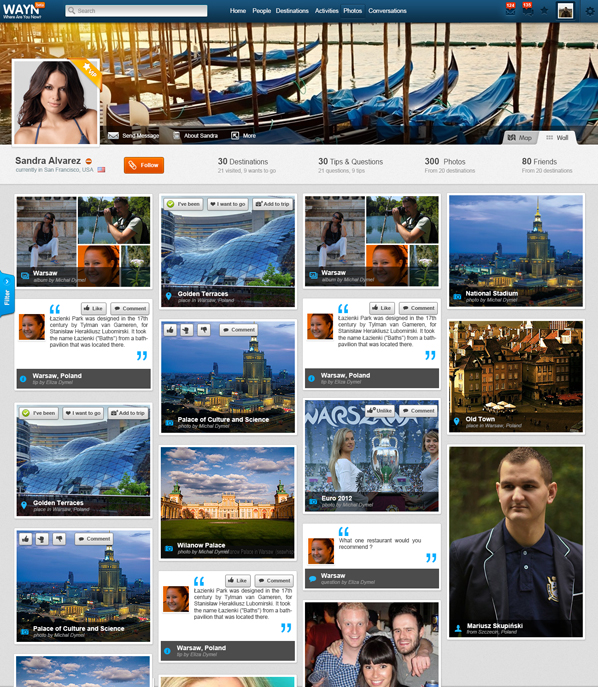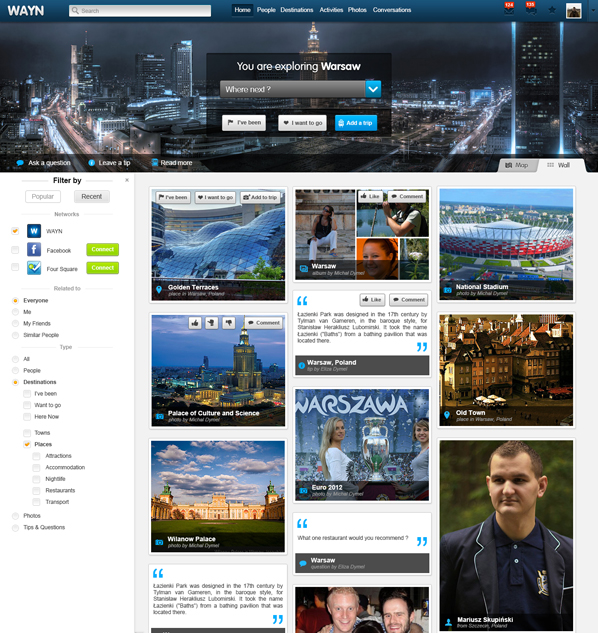Breaking Travel News interview: Peter Ward, founder, WAYN

The largest travel and lifestyle social network in the world, WAYN, has gone live with a new platform, designed to enable its users to better discover where to go, what to do and who to meet.
The new site helps users on a journey of “destination discovery”, provoking inspiration on where to travel to next as well as what to do when you get there and who to connect with to make the most of your experience.
Members of the platform can now search or browse any destination and filter it by their WAYN, Facebook and Foursquare networks with the click of a button, so that they can quickly find recommendations on where to go and what to do, based on what others have already experienced.
Users can also filter the results by people or content type, making it easy to find what they are looking for, by destination.
Content that they like can be pinned to their profile and eventually, they will be able to create customised collections of their favourite things and share them with others.
Breaking Travel News: These are exciting times for WAYN, with the re-launch of the site. Could we start by just getting an update with where we are on that?
Peter Ward: We have rebuilt the site from the ground up, having taken a good amount of time to listen to our existing users, carry out some user testing, and beta test with our more prolific users.
We have matched this with our ten years of experience in the social media space to try and serve up what we hope is much more of a next generation platform which will much better allow our users to discover where to go, what to do, and who to meet.
Up until recently our focus was very much on connecting people on where they are, where they have been and where they are going.
I think we have become very successful in doing that. But where we have perhaps lacked the time and resources to develop is to build around the where to go, what to do aspect.
The new platform, the new site, while still being ten per cent of the vision of what we intend the site to be, is getting some very positive feedback from our partners, our advertisers. People want to be involved with the project. It is a lot more aspirational and contextual.
From a user standpoint the feedback has also been very positive.
We are seeing a lot of engagement with the site, in terms of page views per user, time spent online and a reduction on churn, based on those who have access to it.
It was important for us to get this right. We have taken a lot of time to make sure this is best in class and very representative of where the industry is right now.
This more than just a brand re-launched. While we are also refreshing the logo to make it more in tune with our strategic focus, we are looking at much more than that.
The idea is to take the best of what we already have; the meeting people, the international travel, making friends and engaging around photos, and fusing that with the contextual content, based around travel and lifestyle.
In time we are also looking to integrate third party networks, which will ultimately do better what they do than we can, but serving that up like an a la carte menu to user.
If you think about Facebook with its Timeline, or the Twitter feed, in our case we want to create something like a travel timeline – based on your experiences.
People will be able to view that on a wall view, which is very visually led, or on a map view, where you can see all of your friends, recommendations, tips, everything.
Very quickly users will be able to see where people have been around the world, what they recommend, who they know – and take that forward, make connections with people and plan.
BTN: You recently signed a major deal with India Today? Could you tell us a little bit about the thinking behind that?
PW: They are a larger media conglomerate based in India. They have various publications, some offline, some online. What they didn’t have was a strong presence in the online travel field.
There is a large offline presence, travel magazines for example, but not much online.
But they do have developed ad placement capabilities and a number websites, relationships with tourist boards, airlines, hotels, and blue-chip companies.
The time it would have taken for us to start that from scratch, against partnering with them, was such that we have launched a co-branded version of the site.
If you now log-on to in India you will get a WAYN/Travel Today co-branded site. It is exactly the same site as we have here and in other markets, but integrating some of there on and offline content to WAYN users in India.
What this allows them to do is go to the likes of Lufthansa or British Airways, for example, who are looking to advertise to Indian consumers, and use our platform as another of their many distribution channels to serve that advertising.
It gives them a media presence in online travel in India. They have 100 million+ consumers they have access to, whereas we have four million users in the country, so the deal made sense.

Profile pages on WAYN
BTN: How did this deal come about? Did the company just have the right fit for WAYN, or is it part of a wider strategy to move into developing markets?
PW: We grew virally and naturally, through word of mouth, in India. This is partly down to market forces.
If you look at the trend of the Indian consumer moving onto the internet, gaining access to mobile internet, and the wider rise of the middle class, which used to be pretty much non-existent, while it is now over 150 million people strong, these have all worked in our favour.
But if you also consider travel, it appeals to everybody around the world, not just India.
This allowed us to develop a large footprint in India, and it made sense for us to work with some of the leading commercial advertising partners out there.
It just so happened that the India Today group was probably the best there was for us to do that.
On your wider point, yes, developing markets are going to be important, not just for us, but for all businesses in the western world.
BTN: In what ways do you hope to benefit from these trends?
PW: This is particularly true of travel. If you look at the shift toward the developing markets, it is becoming more apparent.
There is a saturation, even a contraction, in some markets, with people taking fewer holidays, not being able to holiday for so long.
Travel is a discretionary spend, a luxury some people can do without.
We are seeing at the same time, a rise in the number of people that want to travel from emerging markets.
This is something people in these locations have never had access to before, and it is even more aspirational for them because it gives them an opportunity to discover the world, to meet people outside of their normal lives.
We, as WAYN, unlike many companies, especially in the travel industry, have been able to tap into that very effectively, as we are based on the connectedness of people, as opposed to us having to broker relationships with local tourism boards.
WAYN has the audience, now it is a matter of working with partners to monetise that audience and serve them in a way that is localised and relevant to them.
BTN: Do you maintain those relationships, with the travel industry, here, in Europe, and in American?
PW: Half of our revenue still comes from within Europe, so obviously we work with a lot of the leading tourist boards and some of the larger airlines and hotel groups.
Our focus has been mainly with the tourism boards, because we have been able to prove our model to them, how we can really raise the profile of a destinations.
We can provide real information on their return on investment.
I think with airlines and hotels, we are starting to see some real traction in those areas. For example, we have just done a deal with Malaysian Airlines.
Social is often seen as an area where you don’t get a return when it comes to advertising. We are working to change that.
The objectives are often the same as with other partners for them; growing their profile, getting leads to their sites, boosting engagement with their products and services. These are things we can do very well.

The new WAYN homepage
BTN: Do you feel WAYN benefits because it is so tailored to the travel industry? Does this help against your larger competitors?
PW: I think it is a huge selling point for us.
We are not all things to all people. Facebook can never be a site which offers enough focus to meet all the needs of a user who is interested in travel and lifestyle.
So, just like LinkedIn or Pinterest, we are on the map when it comes to interest based social networks.
Thankfully our niche, travel, is one of the largest niche areas in the world, comparable only to music.
Everybody likes a form of music and likes to share their experiences of music. We happen to fall upon the other one, which is a good place for us to be.
Our niche is very social, allowing our users to make new friends, and share experiences with existing ones.
The travel focus has given us a huge advantage and partially explains why we have managed to maintain a market leading position in this space.
BTN: One of the things that comes up when looking at WAYN is the aspirational nature of the site. Facebook, Twitter, these are sites that are based in the now, or even the past, whereas you attempt to look to the future. Would you say that is a fair assessment?
PW: Absolutely. We did a brand strategy a while ago and we found that, while the brand was one of where people are now, what was compelling for our users and advertisers was where people are going next.
What people would love to do in the future is very important to our users.
The future is more unlimited. The mission of our company is to help people make the most out of life.
Life is short and we have a certain amount of time left, so we want to encourage people to be bold, to do stuff.
All this within the context of travel and lifestyle.
With the data we are collecting on users, both where they have been, and where they want to go, we can connect likeminded people together.
For example, somebody who is planning a trip to Paris, they can be put in touch with somebody who lives in Paris, has been to Paris, or is also planning a trip at the same time as them.
They can then share recommendations, plan to meet up, or just talk about experiences.
That who prospective side of the equation makes it very interesting for both our users and advertisers who are looking to target people who have an interest in visiting a location or using a service.
BTN: You mentioned lifestyle there, is that a growing part of what you do? Looking not just at international travel, but offering suggestions on what to do closer to home?
PW: Yes, there is a lot of activity in this space; you just have to look at the social-local-mobile space, it is seen as a holy grail, with every man and
his dog trying to claim there piece of it.
Foursquare, Google, Facebook, they are all in this space.
We are not saying we are going to be better than what these guys do, but what we are saying is that there is an interest in connecting people, not just in terms of travel, but also where they are going tonight in their own city.
We have invested in the last couple of years in the interest side of what people want to do, not just where they want to go. This is everything from those interested in football, to people who want to climb Mt. Everest, to people who have a passion for skiing.
With this information we can provide much more relevant information and offers to people.
If, for example, you are interested in skiing, and you are not too specific about where you want to go, we can work with different destination organisations to make suggestions.
They can say, you have always thought about going to Alps, but how about the Rockies in Colorado?
I think the lifestyle side is important; from our point of view that means interests from outside of travel.
This includes everything activity based.

